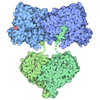[English] 日本語
 Yorodumi
Yorodumi- PDB-5upk: CDC42 binds PAK4 via an extended GTPase-effector interface - 3 pe... -
+ Open data
Open data
- Basic information
Basic information
| Entry | Database: PDB / ID: 5upk | ||||||
|---|---|---|---|---|---|---|---|
| Title | CDC42 binds PAK4 via an extended GTPase-effector interface - 3 peptide: PAK4cat, PAK4-N45, CDC42 | ||||||
 Components Components |
| ||||||
 Keywords Keywords | TRANSFERASE / GTPase / Kinase / CRIB | ||||||
| Function / homology |  Function and homology information Function and homology informationGBD domain binding / Golgi transport complex / positive regulation of pinocytosis / dendritic cell migration / endothelin receptor signaling pathway involved in heart process / cardiac neural crest cell migration involved in outflow tract morphogenesis / storage vacuole / apolipoprotein A-I receptor binding / positive regulation of epithelial cell proliferation involved in lung morphogenesis / neuron fate determination ...GBD domain binding / Golgi transport complex / positive regulation of pinocytosis / dendritic cell migration / endothelin receptor signaling pathway involved in heart process / cardiac neural crest cell migration involved in outflow tract morphogenesis / storage vacuole / apolipoprotein A-I receptor binding / positive regulation of epithelial cell proliferation involved in lung morphogenesis / neuron fate determination / organelle transport along microtubule / regulation of attachment of spindle microtubules to kinetochore / Inactivation of CDC42 and RAC1 / positive regulation of pseudopodium assembly / cardiac conduction system development / host-mediated perturbation of viral process / dendritic spine development / cadherin binding involved in cell-cell adhesion / regulation of filopodium assembly / leading edge membrane / neuropilin signaling pathway / establishment of Golgi localization / GTP-dependent protein binding / adherens junction organization / cell junction assembly / filopodium assembly / establishment of epithelial cell apical/basal polarity / dendritic spine morphogenesis / regulation of lamellipodium assembly / thioesterase binding / regulation of stress fiber assembly / embryonic heart tube development / RHO GTPases activate KTN1 / Activation of RAC1 / DCC mediated attractive signaling / regulation of postsynapse organization / CD28 dependent Vav1 pathway / Wnt signaling pathway, planar cell polarity pathway / positive regulation of filopodium assembly / RHOV GTPase cycle / phagocytosis, engulfment / nuclear migration / small GTPase-mediated signal transduction / regulation of mitotic nuclear division / Myogenesis / heart contraction / positive regulation of cytokinesis / spindle midzone / RHOJ GTPase cycle / RHOQ GTPase cycle / establishment of cell polarity / Golgi organization / establishment or maintenance of cell polarity / RHOU GTPase cycle / RHO GTPases activate PAKs / regulation of MAPK cascade / CDC42 GTPase cycle / macrophage differentiation / RHOH GTPase cycle / RHOG GTPase cycle / RAC2 GTPase cycle / RAC3 GTPase cycle / RHO GTPases Activate WASPs and WAVEs / negative regulation of endothelial cell apoptotic process / RHO GTPases activate IQGAPs / negative regulation of protein-containing complex assembly / positive regulation of lamellipodium assembly / GPVI-mediated activation cascade / positive regulation of stress fiber assembly / phagocytic vesicle / RAC1 GTPase cycle / EPHB-mediated forward signaling / cytoskeleton organization / positive regulation of substrate adhesion-dependent cell spreading / substantia nigra development / Gene and protein expression by JAK-STAT signaling after Interleukin-12 stimulation / actin filament organization / cellular response to starvation / small monomeric GTPase / integrin-mediated signaling pathway / regulation of actin cytoskeleton organization / FCGR3A-mediated phagocytosis / adherens junction / filopodium / regulation of cell growth / EGFR downregulation / RHO GTPases Activate Formins / MAPK6/MAPK4 signaling / Regulation of actin dynamics for phagocytic cup formation / cellular response to type II interferon / VEGFA-VEGFR2 Pathway / endocytosis / cytoplasmic ribonucleoprotein granule / apical part of cell / positive regulation of angiogenesis / G beta:gamma signalling through CDC42 / cell-cell junction / mitotic spindle / ubiquitin protein ligase activity / intracellular protein localization Similarity search - Function | ||||||
| Biological species |  Homo sapiens (human) Homo sapiens (human) | ||||||
| Method |  X-RAY DIFFRACTION / X-RAY DIFFRACTION /  SYNCHROTRON / SYNCHROTRON /  MOLECULAR REPLACEMENT / Resolution: 2.4 Å MOLECULAR REPLACEMENT / Resolution: 2.4 Å | ||||||
 Authors Authors | Ha, B.H. / Boggon, T.J. | ||||||
| Funding support |  United States, 1items United States, 1items
| ||||||
 Citation Citation |  Journal: Proc. Natl. Acad. Sci. U.S.A. / Year: 2018 Journal: Proc. Natl. Acad. Sci. U.S.A. / Year: 2018Title: CDC42 binds PAK4 via an extended GTPase-effector interface. Authors: Ha, B.H. / Boggon, T.J. | ||||||
| History |
|
- Structure visualization
Structure visualization
| Structure viewer | Molecule:  Molmil Molmil Jmol/JSmol Jmol/JSmol |
|---|
- Downloads & links
Downloads & links
- Download
Download
| PDBx/mmCIF format |  5upk.cif.gz 5upk.cif.gz | 220.8 KB | Display |  PDBx/mmCIF format PDBx/mmCIF format |
|---|---|---|---|---|
| PDB format |  pdb5upk.ent.gz pdb5upk.ent.gz | 174.6 KB | Display |  PDB format PDB format |
| PDBx/mmJSON format |  5upk.json.gz 5upk.json.gz | Tree view |  PDBx/mmJSON format PDBx/mmJSON format | |
| Others |  Other downloads Other downloads |
-Validation report
| Summary document |  5upk_validation.pdf.gz 5upk_validation.pdf.gz | 1.1 MB | Display |  wwPDB validaton report wwPDB validaton report |
|---|---|---|---|---|
| Full document |  5upk_full_validation.pdf.gz 5upk_full_validation.pdf.gz | 1.1 MB | Display | |
| Data in XML |  5upk_validation.xml.gz 5upk_validation.xml.gz | 20.1 KB | Display | |
| Data in CIF |  5upk_validation.cif.gz 5upk_validation.cif.gz | 27.2 KB | Display | |
| Arichive directory |  https://data.pdbj.org/pub/pdb/validation_reports/up/5upk https://data.pdbj.org/pub/pdb/validation_reports/up/5upk ftp://data.pdbj.org/pub/pdb/validation_reports/up/5upk ftp://data.pdbj.org/pub/pdb/validation_reports/up/5upk | HTTPS FTP |
-Related structure data
| Related structure data | 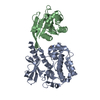 5uplC  4fijS C: citing same article ( S: Starting model for refinement |
|---|---|
| Similar structure data |
- Links
Links
- Assembly
Assembly
| Deposited unit | 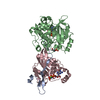
| ||||||||
|---|---|---|---|---|---|---|---|---|---|
| 1 |
| ||||||||
| Unit cell |
|
- Components
Components
-Serine/threonine-protein kinase PAK ... , 2 types, 2 molecules AB
| #1: Protein/peptide | Mass: 5653.328 Da / Num. of mol.: 1 / Fragment: UNP residues 1-45 Source method: isolated from a genetically manipulated source Source: (gene. exp.)  Homo sapiens (human) / Gene: PAK4, KIAA1142 / Variant: isoform2 / Plasmid: modified pET28a / Production host: Homo sapiens (human) / Gene: PAK4, KIAA1142 / Variant: isoform2 / Plasmid: modified pET28a / Production host:  References: UniProt: O96013, non-specific serine/threonine protein kinase |
|---|---|
| #2: Protein | Mass: 39123.133 Da / Num. of mol.: 1 / Fragment: UNP residues 109-426 Source method: isolated from a genetically manipulated source Source: (gene. exp.)  Homo sapiens (human) / Gene: PAK4, KIAA1142 / Variant: isoform2 / Plasmid: pET28a / Production host: Homo sapiens (human) / Gene: PAK4, KIAA1142 / Variant: isoform2 / Plasmid: pET28a / Production host:  References: UniProt: O96013, non-specific serine/threonine protein kinase |
-Protein , 1 types, 1 molecules C
| #3: Protein | Mass: 20729.787 Da / Num. of mol.: 1 / Mutation: Q61L Source method: isolated from a genetically manipulated source Source: (gene. exp.)  Homo sapiens (human) / Gene: CDC42 / Plasmid: pET22b / Production host: Homo sapiens (human) / Gene: CDC42 / Plasmid: pET22b / Production host:  |
|---|
-Non-polymers , 4 types, 28 molecules 
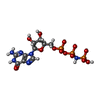





| #4: Chemical | ChemComp-ANP / |
|---|---|
| #5: Chemical | ChemComp-GNP / |
| #6: Chemical | ChemComp-MG / |
| #7: Water | ChemComp-HOH / |
-Details
| Has protein modification | Y |
|---|
-Experimental details
-Experiment
| Experiment | Method:  X-RAY DIFFRACTION / Number of used crystals: 1 X-RAY DIFFRACTION / Number of used crystals: 1 |
|---|
- Sample preparation
Sample preparation
| Crystal | Density Matthews: 2.34 Å3/Da / Density % sol: 47.42 % |
|---|---|
| Crystal grow | Temperature: 295 K / Method: vapor diffusion, hanging drop / pH: 7.5 / Details: 0.1M HEPES pH 7.5, 22% PEG1,000 / PH range: 7.0-8.0 / Temp details: R/T |
-Data collection
| Diffraction | Mean temperature: 100 K |
|---|---|
| Diffraction source | Source:  SYNCHROTRON / Site: SYNCHROTRON / Site:  APS APS  / Beamline: 24-ID-E / Wavelength: 0.9792 Å / Beamline: 24-ID-E / Wavelength: 0.9792 Å |
| Detector | Type: ADSC QUANTUM 315 / Detector: CCD / Date: Feb 10, 2014 |
| Radiation | Monochromator: Si (111) / Protocol: SINGLE WAVELENGTH / Monochromatic (M) / Laue (L): M / Scattering type: x-ray |
| Radiation wavelength | Wavelength: 0.9792 Å / Relative weight: 1 |
| Reflection | Resolution: 2.4→50 Å / Num. obs: 24144 / % possible obs: 100 % / Redundancy: 10.9 % / Rmerge(I) obs: 0.163 / Rsym value: 0.163 / Net I/σ(I): 12 |
| Reflection shell | Resolution: 2.4→2.49 Å / Redundancy: 10.6 % / CC1/2: 0.311 / Rpim(I) all: 0.912 / % possible all: 100 |
- Processing
Processing
| Software |
| ||||||||||||||||||||||||||||||||||||||||||||||||||||||||||||||||||||||||||||||||||||||||||||||||||||||||||||||||||||||||||||||||||||||||||||||||||||||||||||||||||||||||||||||||||||||
|---|---|---|---|---|---|---|---|---|---|---|---|---|---|---|---|---|---|---|---|---|---|---|---|---|---|---|---|---|---|---|---|---|---|---|---|---|---|---|---|---|---|---|---|---|---|---|---|---|---|---|---|---|---|---|---|---|---|---|---|---|---|---|---|---|---|---|---|---|---|---|---|---|---|---|---|---|---|---|---|---|---|---|---|---|---|---|---|---|---|---|---|---|---|---|---|---|---|---|---|---|---|---|---|---|---|---|---|---|---|---|---|---|---|---|---|---|---|---|---|---|---|---|---|---|---|---|---|---|---|---|---|---|---|---|---|---|---|---|---|---|---|---|---|---|---|---|---|---|---|---|---|---|---|---|---|---|---|---|---|---|---|---|---|---|---|---|---|---|---|---|---|---|---|---|---|---|---|---|---|---|---|---|---|
| Refinement | Method to determine structure:  MOLECULAR REPLACEMENT MOLECULAR REPLACEMENTStarting model: 4FIJ Resolution: 2.4→50.01 Å / Cor.coef. Fo:Fc: 0.947 / Cor.coef. Fo:Fc free: 0.916 / SU B: 25.02 / SU ML: 0.263 / Cross valid method: THROUGHOUT / ESU R: 0.415 / ESU R Free: 0.271 / Stereochemistry target values: MAXIMUM LIKELIHOOD / Details: HYDROGENS HAVE BEEN ADDED IN THE RIDING POSITIONS
| ||||||||||||||||||||||||||||||||||||||||||||||||||||||||||||||||||||||||||||||||||||||||||||||||||||||||||||||||||||||||||||||||||||||||||||||||||||||||||||||||||||||||||||||||||||||
| Solvent computation | Ion probe radii: 0.8 Å / Shrinkage radii: 0.8 Å / VDW probe radii: 1.2 Å / Solvent model: MASK | ||||||||||||||||||||||||||||||||||||||||||||||||||||||||||||||||||||||||||||||||||||||||||||||||||||||||||||||||||||||||||||||||||||||||||||||||||||||||||||||||||||||||||||||||||||||
| Displacement parameters | Biso mean: 68.109 Å2
| ||||||||||||||||||||||||||||||||||||||||||||||||||||||||||||||||||||||||||||||||||||||||||||||||||||||||||||||||||||||||||||||||||||||||||||||||||||||||||||||||||||||||||||||||||||||
| Refinement step | Cycle: 1 / Resolution: 2.4→50.01 Å
| ||||||||||||||||||||||||||||||||||||||||||||||||||||||||||||||||||||||||||||||||||||||||||||||||||||||||||||||||||||||||||||||||||||||||||||||||||||||||||||||||||||||||||||||||||||||
| Refine LS restraints |
|
 Movie
Movie Controller
Controller




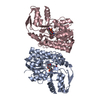
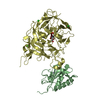


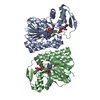
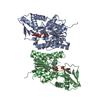
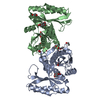
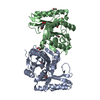
 PDBj
PDBj


















